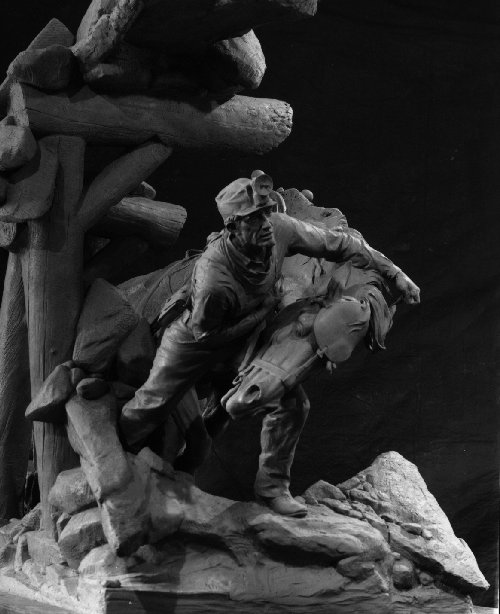CLEARING the HAULWAY
by Edward J. Fraughton
Price: $14,000 (Scale working model for the monument)
Status: Available
Size: 20.5 inches high
Media: Cast Bronze
This monument was commissioned by Sweetwater County for Rock Springs, Wyoming as a tribute to the men, women and children who worked in the coal mining industry there. After the completion of the trans-continental railroad in 1869, Rock Springs was perfectly positioned to supply fuel for the railroad and for trans-oceanic transportation and shipping. Rock Springs coal, with its higher sulphur content, was more desireable because it burned hotter than most other coals of lesser quality. More heat-per-pound was gold to the railroad and shipping and to the homes and businesses who were moving rapidly toward industrialization, mass transportation and central heating. Those who struggled to remove the coal from the ground were mostly hard-working, short-lived imigrant Irish, Swedes, Italians, English, Dutch and Chinese lived and worked at the mercy of the company who owned the town and their homes. Growing up as a child in Park City, Utah, gave me a real first-hand sense of the old mining town atmosphere and mentality. There were no etnic, religious or cultural barriers there. From all corners of the earth, people found a way to rise above their common lot to encourage help and sustain one another, particularly during the "hard times."
This monument to the mining industry represents the importance of man and horse working together to create and clear out a first hole. It portrays the two figures in a struggling cooperative embrace of sorts, to achieve a common goal. Where the focus of the industry is the product, the focus of the monument is humanity. Surrounding the man and horse team is the abstract framework of the mountain with its straining timber supports, the hard rocky ground strewn with surrounding necessary tools of the trade. The frame box skid on steel runners with removable sides is merely an invention in practicality. If I had the problem without the benefit of rails or wheeled box cars in the beginning, the challenge as well as the result is more creative than practical. However, given the problem, this is the way I might have solved it with available materials and tools.
 ORDERING Information
ORDERING Information



